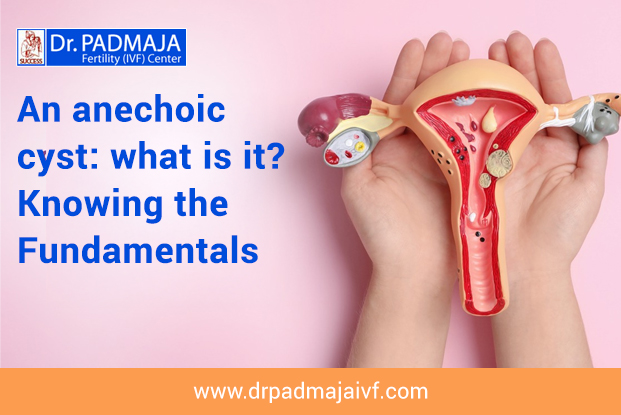When it comes to women’s health, many medical terms can sound confusing and even a little intimidating. One such term is “anechoic cyst.” If you’ve recently seen this phrase on an ultrasound report or heard it from your doctor, you may be wondering what it means and whether it should be a cause for concern. The truth is, most anechoic cysts are harmless, but understanding the basics can give you peace of mind and help you make informed decisions about your health.
In this blog, we’ll explore what anechoic cysts are, why they occur, when to worry, and how fertility specialists at trusted centers like Dr Padmaja IVF Center, widely recognized as one of the best IVF centers in Hyderabad, can guide you with the right care.
What Is an Anechoic Cyst?
An anechoic cyst is a fluid-filled sac that appears as a dark or “echo-free” area on an ultrasound. The word “anechoic” simply means that the cyst does not reflect sound waves during imaging. This is why, on an ultrasound screen, it shows up as a black area surrounded by tissue.
These cysts are commonly found in the ovaries, uterus, or even kidneys. In women, ovarian anechoic cysts are most common and are usually functional cysts that form as part of the menstrual cycle. In most cases, they are:
Benign (non-cancerous)
Filled with fluid rather than solid material
Temporary, often resolving on their own within a few weeks or months
Causes of Anechoic Cysts
Anechoic cysts can develop due to several reasons. Some common causes include:
Hormonal changes – Functional ovarian cysts form naturally during ovulation.
Blocked ducts – In certain organs, ducts that carry fluid may get blocked, leading to cyst formation.
Pregnancy-related changes – Some cysts develop during early pregnancy but usually resolve without treatment.
Underlying conditions – Though rare, cysts can sometimes be linked to conditions like polycystic ovary syndrome (PCOS) or endometriosis.
Symptoms of Anechoic Cysts
In many cases, women don’t even realize they have a cyst because it produces no symptoms and is discovered during a routine ultrasound. However, larger cysts may cause:
Pelvic pain or pressure
Bloating or swelling in the abdomen
Changes in the menstrual cycle
frequent urine if the bladder is compressed by the cyst
If you ever experience sudden, sharp pelvic pain, nausea, or dizziness, it could indicate a ruptured cyst or twisting of the ovary (ovarian torsion). These situations require immediate medical attention.
Are Anechoic Cysts Dangerous?
Most anechoic cysts are not dangerous and disappear on their own. However, in some cases, they may persist, grow larger, or show unusual features on imaging. Doctors usually monitor them with follow-up ultrasounds to ensure they are shrinking and not causing complications.
Rarely, cysts can indicate more serious issues such as ovarian tumors. That’s why regular check-ups with a specialist are important to rule out complications.
Anechoic Cysts and Fertility
A big concern for many women is whether an anechoic cyst can affect fertility. The answer depends on the type and size of the cyst.
Functional cysts (common in ovulation) usually do not affect fertility and may even indicate healthy reproductive function.
Large or persistent cysts may interfere with ovulation or cause discomfort, making conception difficult.
Cysts linked to PCOS or endometriosis may require treatment, as these conditions can affect fertility.
This is where consulting an experienced fertility specialist becomes vital. At Dr Padmaja IVF Center, doctors carefully evaluate cysts, understand your medical history, and suggest the best course of action to protect both your health and your chances of conceiving.
Diagnosis and Treatment
Diagnosis of an anechoic cyst is typically done through ultrasound. Depending on its size and nature, your doctor may recommend:
Watchful waiting – Monitoring the cyst with regular ultrasounds, especially if it’s small and symptom-free.
Medication – Birth control pills may sometimes be prescribed to prevent new cysts from forming.
Surgery – If a cyst is very large, persistent, or causing severe pain, surgical removal (laparoscopy or laparotomy) may be suggested.
At trusted facilities like Dr Padmaja Fertility Center, the focus is always on preserving ovarian health and ensuring that treatment does not interfere with future fertility goals.
When to See a Doctor
It’s important to see a doctor if you experience:
Severe or persistent pelvic pain
Irregular or heavy periods
Difficulty in conceiving
Sudden abdominal pain with nausea or vomiting
Even if most cysts are harmless, early evaluation ensures that nothing serious is overlooked.
Why Choose Dr Padmaja IVF Center for Guidance?
If you’re in Hyderabad and concerned about an anechoic cyst or its effect on your fertility, visiting a trusted clinic makes all the difference. Dr Padmaja IVF Center, regarded as the best IVF center in Hyderabad, offers:
Advanced ultrasound and diagnostic facilities
Expert gynecologists and fertility specialists
Personalized treatment plans based on your health and goals
Compassionate counseling to ease your worries
At Dr Padmaja Fertility Center, women receive not only medical care but also emotional support, ensuring that they feel confident in their journey toward better reproductive health.
Final Thoughts
Hearing the term anechoic cyst for the first time can feel overwhelming, but in most cases, these cysts are harmless and temporary. Still, paying attention to your body and seeking medical advice is crucial. Whether you’re managing symptoms, planning for pregnancy, or simply want reassurance, the right medical team can help you make the best decisions.
If you are searching for professional care and fertility expertise, consider consulting Dr Padmaja IVF Center, one of the most trusted names in Hyderabad. With their guidance, you can manage your health confidently while keeping your fertility journey on track.
About the Author

This blog is penned by a devoted content specialist passionate about raising awareness around fertility treatments and emotional well- being. With in- depth disquisition on motifs like IVF and fertility, the thing is to give precious perceptivity for couples on their trip to parenthood.
Frequently Asked Questions (FAQs)
1.What is an anechoic cyst?
An anechoic cyst is a fluid-filled sac that appears completely dark or “anechoic” on an ultrasound. The term “anechoic” means that the cyst does not reflect sound waves, which is why it shows up as a black area on imaging. These cysts are usually benign and non-cancerous.
2.How is an anechoic cyst detected?
A doctor typically detects an anechoic cyst using imaging techniques like ultrasound. Because these cysts are fluid-filled, they are easily visible on ultrasound scans.
3.Where can anechoic cysts appear in the body?
Anechoic cysts can develop in various organs, including the ovaries, kidneys, liver, or breasts. The location often determines whether treatment is needed.
4.Are anechoic cysts dangerous?
Most anechoic cysts are harmless and do not cause symptoms. However, in rare cases, cysts may grow large, cause discomfort, or affect the functioning of the organ they are in.
5.What are the common symptoms of an anechoic cyst?
Many anechoic cysts do not cause symptoms. If symptoms occur, they may include mild pain, swelling, or pressure in the affected area.
6.How are anechoic cysts treated?
Treatment is not always necessary. If a cyst is small and asymptomatic, doctors may recommend regular monitoring. Larger or symptomatic cysts might require drainage or surgical removal, depending on the location and type.

